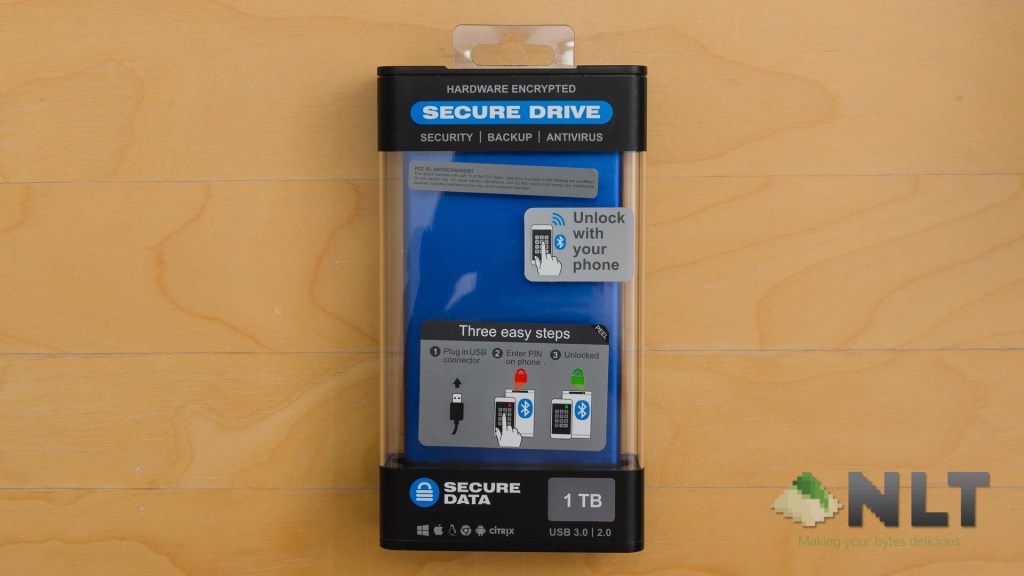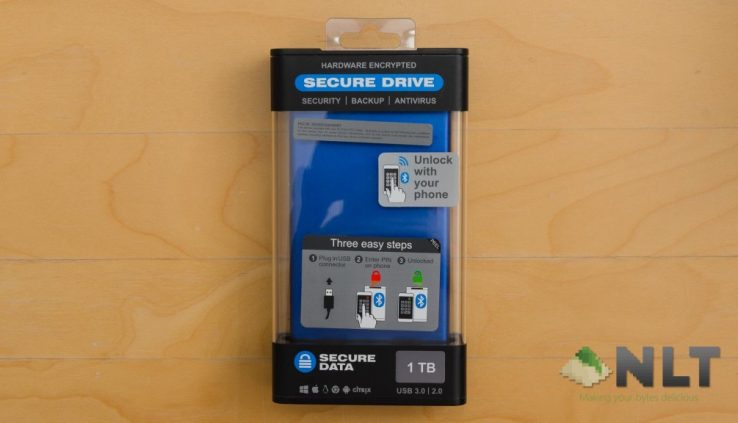Review – SecureDrive BT portable SSD (1TB)
By Adam Noyes
When we first knew about SecureDrive, we went on to their website to check out what they have in their catalog of products. We found out that they specialize in manufacturing encrypted external storage devices with high-grade security – and is also a part of SecureData. We then got the SecureDrive BT portable SSD on our hands because it is honestly, a unique product.
The SecureDrive is available in both BT (the one we have) and KP (keycap) variants. In this review, we are focusing on the SecureDrive BT only.
Unboxing

We were sent the SecureDrive BT with 1TB in capacity. The packaging itself is rather special as it has a bunch of useful information on the plastic shell.
At the back of the packaging shell, there are mentions of the key highlight points about the SecureDrive BT. Interestingly, they are using hardware-based AES 256-bit XTS hardware encryption. It also comes with a 2-year warranty!
Opening up the shell – which has tabs instead of tape – reveals just 3 things – the SecureDrive BT itself, a really simple quick start guide, and also a USB 3.0 Type-A to USB 3.0 Micro-B.
The SecureDrive BT itself
This drive has a pretty simple design overall. It comes in this blue aluminium case and has the company name SecureDrive printed at the front. There are black pieces at the bottom and top, with some indicator LEDs at the latter.
The micro USB 3.0 cable plugs in at the top and it is rather disappointing as I was hoping it would be using USB-C instead. Its pairing code is above the USB port too. This pairing code is unique for all drives and is used to pair with the DataLock app – which we will talk about later.
At the back of the drive is the serial number. Remember to keep the serial code somewhere safe as it is necessary for certain features in the DataLock app.
Looking around the drive itself, there are no obvious ways to pry open the drive to get the SSD out, bypassing the hardware security. Even if the drive does get pried apart, the data inside the SSD is already encrypted with AES 256-bit XTS. So, you can’t read the data willy nilly.
The DataLock companion app
To use the SecureDrive BT, you’ll need 3 things:
- A smartphone (iOS or Android)
- Internet connection
- Bluetooth
Download and install the SecureDrive BT app onto your smartphone – it’s free for both iOS and Android. Opening the app will prompt you to add your drive into the app itself. It’s a very straightforward process, honestly.
Once you downloaded the app, it will ask you to pair up the drive with your SecureDrive BT. This is where the pairing code comes in – just enter the code when prompted and you will have the drive added to your app.
After that, the app will ask you to set a password for the drive. Type in any password you want and it will be saved. Then, it will also ask if you want to have password recovery in case you forgot your password. This will require your phone number, and it will send in an activation code via SMS.
Once that’s done, the drive will unlock itself and you’ll be able to use the drive on any devices you like – Windows PC, Mac, Linux, Android, iOS, Chrome OS, or even Citrix. I personally recommend you to format the drive in exFAT file system for maximum compatibility across all operating systems.

From here, you can use the drive as is – or head back to the DataLock app and further customize your SecureDrive BT. I personally have these settings for my SecureDrive BT.

Here’s a quick rundown of some features found in the DataLock app:
- Password/Access
- Change name: Renames the drive name that appears in the DataLock app, independent from the name detected in the operating system.
- 2-factor authentication: Requires an activation code (sent via SMS) to unlock after keying in the correct password.
- Password recovery: To recover your password if forgotten, need to be tied in to your phone number first.
- Remember password: Self-explanatory. Not recommended.
- Biometric unlock: Instead of a password, it can be unlocked via face or fingerprint. Applicable for both iOS and Android.
- Locking options
- Inactivity auto-lock: If the SecureDrive BT is left idle for a set amount of time, it will automatically lock itself
- Step-away auto-lock: Using your smartphone a “proximity sensor” via Bluetooth, the drive will automatically lock itself if it gets too far away from your phone.
- Read-only: Sets the SecureDrive BT to read-only mode. Perfect if you are copying files into a public PC.
There is also an option to remotely wipe the SecureDrive BT if you lose it. However, you’ll need to enable this option to arm the drive first. Then, in case the drive is lost, you can trigger the remote wipe to happen the next time this particular SecureDrive BT connects to the DataLock app.
It is here that the serial number of your SecureDrive BT is important. The serial number found in two places – on the SecureDrive BT itself, and also at the dashboard of the DataLock app.
Though, I wouldn’t be concerned since the drive automatically wipes itself after 10 failed unlocking attempts. This feature cannot be disabled or changed, and it essentially makes the remote wipe feature to be instantaneous.
Speedy external SSD
Alas, the SecureDrive BT is still an external SSD in essence. From what we can find out, the SecureDrive BT is equipped with an off-the-shelf consumer-grade, 2.5-inch SATA III-based QLC SSD. The one we have is a 1TB Samsung 860 QVO SSD.
By looking at the drive model, it makes sense why the SecureDrive has this dimension. It is only slightly larger than a 2.5-inch storage drive, though opting for an M.2 SSD might result in a much smaller form factor.
We tested the performance of the SecureDrive BT (1TB) and the performance is somewhat okay. It is definitely not the speediest in the market, but it is much faster than a traditional spinning hard disk drive.


Wrapping up the SecureDrive BT review
This drive has really useful security features built-in into the hardware itself. The DataLock companion app accentuates those features by offering some customizability in terms of how you want to lock/unlock the drive. However, because of how the drives need to talk to the server every time you want to unlock the drive, you’ll need an internet connection on your phone.
However, there is room for improvement here. I hope the next generation of SecureDrive BT will be using USB-C. I also hope for a much smaller form factor – which is achievable by using an M.2 SSD instead.
Overall, I think the SecureDrive BT is a very well-made product for its intended purpose. Both hardware and software complement each other, creating a fantastic user experience.
- SecureDrive BT: from USD $285
- SecureUSB BT: from USD $119
- SecureDrive KP: from USD $275
- SecureUSB KP: from USD $89










